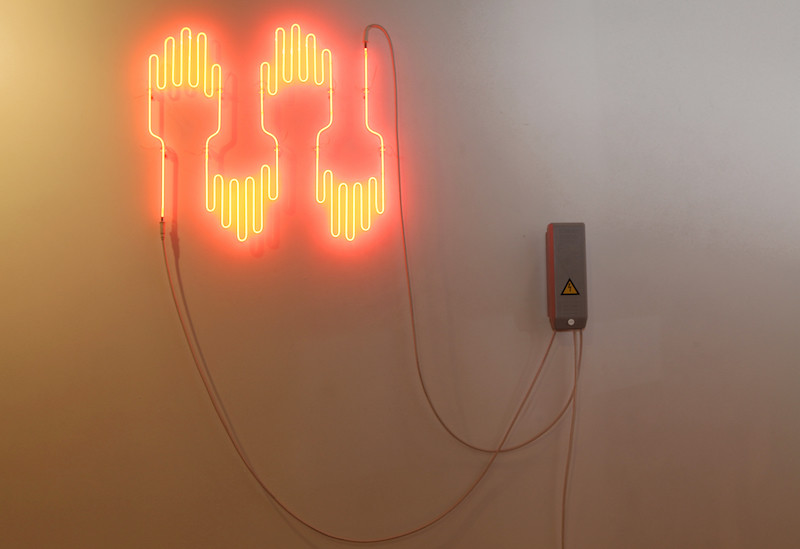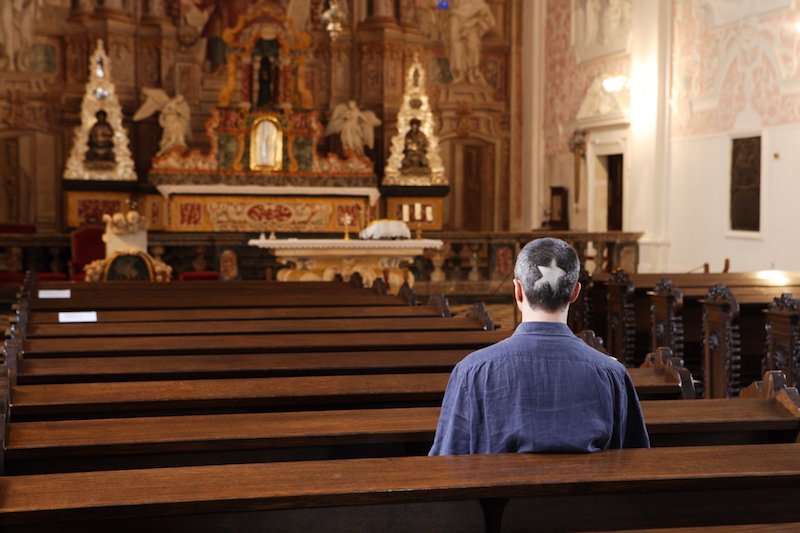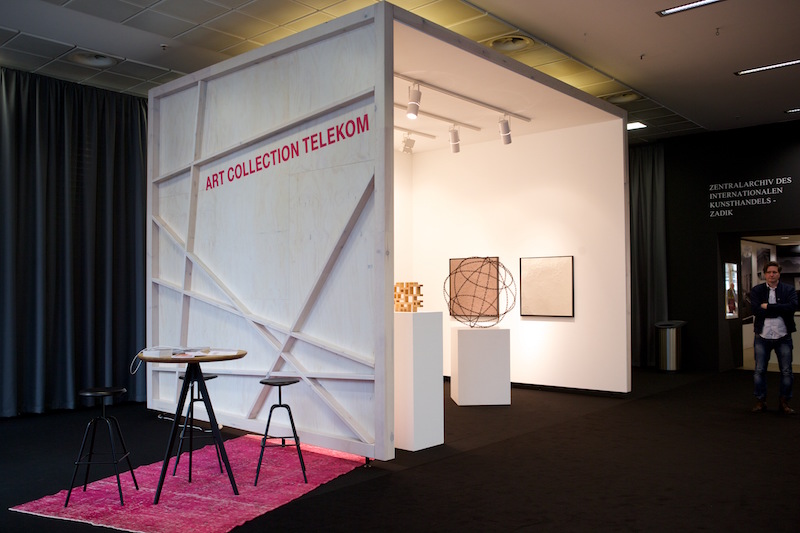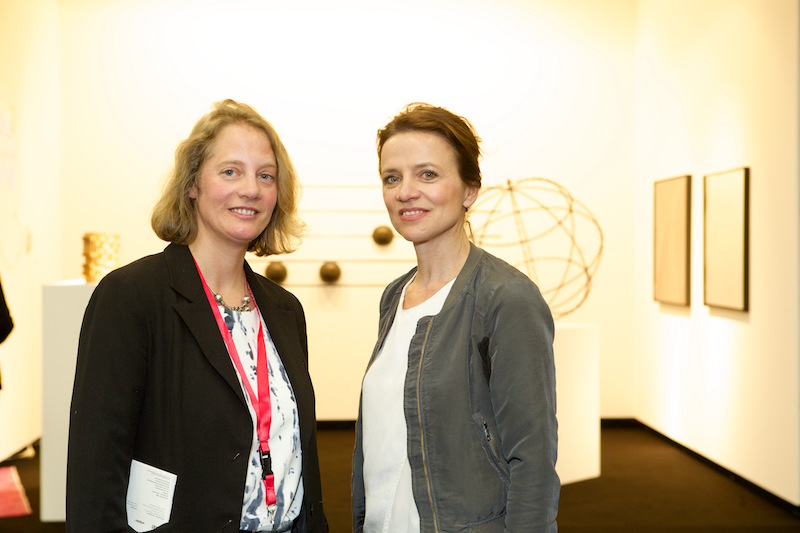
Little Warsaw "Fence", 2012; at ART COLOGNE 2016
– In Collaboration with Deutsche Telekom AG –
At this year’s Art Cologne a well curated booth greets the visitors right before they are entering the main hall: The Art Collection Deutsche Telekom. With a focus on Eastern European Art, this collection takes a rare stand in the collector’s market and is actually one oft he few booths at the whole fair hinting into the direction of how current political events are affecting artists around Europe. Two newly acquired positions are being presented: Nevin Aladağ who was born in 1970 in Turkey, but grew up in Berlin and the artistic duo Little Warsaw, born in 1970 and 71, who are both originally from Budapest although the name might suggest otherwise. Growing up in different surroundings, both positions deal with their backgrounds diversely. However, they find common ground in their mutual artistic focus on matters of heritage and cultural identification.
While Nevil Aladağ, who is mainly known for her multi-channeled video installations and sound elements, concentrates on subjects of external perception and self-awareness shaped through her Turkish-German heritage, Little Warsaw create objects and pieces that process the transformation of the post-socialistic society after the cold war in Hungary. Although both, Aladağ and Little Warsaw, often confront cultural matters with regards to their respective countries’ histories, traditions and heritages, their work has gained a particular up-to-dateness during the latest political events. We sat down for a chat with Antje Hundhausen, Vice president for marketing communication at Telekom and Nathalie Hoyos, curator of the collection alongside Rainald Schumacher.
Anneli Botz: If you want to build up an art collection, the Eastern European market is not necessarily a traditional choice. Who came up with this rather unconventional idea?
Nathalie Hoyos: Obviously it is quite a big deal for a corporate brand like Telekom to establish itself in the art market with a completely new collection and for the first time. To avoid the risk of becoming arbitrary we decided early on to set some geographical or content-related boundaries. At the time, the Eastern European art market was just beginning to open up. Countries started re-approaching their own art history for the first time after the cold war and institutions like the Centre Pompidou in Paris or the Tate Modern in London quickly began building up collections for Eastern European art. It just seemed like a very interesting field to start a young collection and it turned out to be the right decision as there are only very few collectors that to what we do.

 Nevin Aladag "Tusch (Carnival)", 2015, at ART COLOGNE 2016; Photo: Deutsche Telekom
Nevin Aladag "Tusch (Carnival)", 2015, at ART COLOGNE 2016; Photo: Deutsche Telekom

 Nevin Aladag "Tusch (Carnival)", 2015, at ART COLOGNE 2016; Photo: Deutsche Telekom
Nevin Aladag "Tusch (Carnival)", 2015, at ART COLOGNE 2016; Photo: Deutsche Telekom
AB: Have you noticed changes within the Eastern European art scene in the past years and how does it differ from the so-called Western art world?
NH: First of all it makes a huge difference whether you talk to artists that actually lived during times of the cold war or whether you speak to those who only know of these days through their parents and grandparents. Today, many of the young artists still make work about the time of the cold war, or show references to artists that lived during those years. If you compare it to western artists, the pictorial language does not really differ much. It is more the depiction of history and topics that shows another background and another way of storytelling. Another difference is that circumstances of production are very problematic in Eastern European Countries nowadays because there is literally no money to support the creative industry.
Antje Hundhausen: This was another reason for us to start the collection as we wanted to endorse artists from areas with weak infrastructure. It was our goal to make a mark, to create more transparency and to help opening up the market to the Western world. Now it's getting even more difficult for artists from Eastern Europe due to the political development.
 Sukran Moral "Bordello", 2005, 1-Channel video projection, color, sound, 08'02", video still; Art Collection Telekom
Sukran Moral "Bordello", 2005, 1-Channel video projection, color, sound, 08'02", video still; Art Collection Telekom
 Sukran Moral "Bordello", 2005, 1-Channel video projection, color, sound, 08'02", video still; Art Collection Telekom
Sukran Moral "Bordello", 2005, 1-Channel video projection, color, sound, 08'02", video still; Art Collection Telekom
AB: Do artists also communicate these issues to you?
NH: Yes, this is always a topic in our discussions. They report neither the art scene in Hungary, nor in Poland is in a very good state right now. Censorship often works much more subtle than one would imagine. Obviously nobody from the government publicly announces the limitations the cultural industry has to undergo now. Instead they simply cut off the money supply and make it almost impossible for artists and museums to keep on going. This is especially a problem for museums in Poland, where institutions used to have some kind of acquisition budget to build up their collections. All these funds are gone now, which is quite a drastic development, keeping in mind that the new government has only been in office for six months. Instead, money is now being put into the promotion of more folkloristic tendencies, while contemporary art is slowly being extinguished from the museums.
AB: Keeping recent developments in mind your collection seems to take a remarkable standing. How is it different to other corporate collections?
AH: We are not as status-orientated. While other collections focus on prestige and buy Gerhard Richter or Picasso, we decided to explore a niche. This was difficult from time to time, as our artists often present darker subject matters that are not always easily accessible. Even Telekom’s board and management was not entirely convinced in the beginning and we had to do some persuading work but it certainly paid off. It's nice to notice that the management is now proud to have such a strong collection with a distinct and powerful voice.
NH: In my opinion you always win when you put content-related matters first as opposed to focusing on everything else surrounding it. This might appear a little less attractive in the beginning, but definitely pays off in the long run. A collection like ours is a lot less disposable than others as it lives of character and strength.
 Igor Grubic "366 Liberation Rituals", 2008-2009; photographs arranged in 33 plates, detail; Art Collection Telekom
Igor Grubic "366 Liberation Rituals", 2008-2009; photographs arranged in 33 plates, detail; Art Collection Telekom
 Igor Grubic "366 Liberation Rituals", 2008-2009; photographs arranged in 33 plates, detail; Art Collection Telekom
Igor Grubic "366 Liberation Rituals", 2008-2009; photographs arranged in 33 plates, detail; Art Collection Telekom
AB: How do artist react when you ask them to become a part of the collection?
NH: Ecstatic! They welcome us with open arms! It was a bit problematic in the beginning though. Nobody really knew whether they could trust us and if we were going to create something of substance. The image of a big corporate brand is not always a plus in this process. We had to overcome some first obstacles but are very well respected today.
AH: It is of great importance to us, to not only build up careers, but to also accompany them, to prove consistency and commitment. Instead of creating something disposable, we count on trust and on the lifelong bond between an artist and a collection.
Art Collection Telekom can be explored online: art-collection-telekom.com

 Booth of the Telekom at ART COLOGNE 2016 ; Nathalie Hoyos and Antje Hundhausen ; Photo: Telekom
Booth of the Telekom at ART COLOGNE 2016 ; Nathalie Hoyos and Antje Hundhausen ; Photo: Telekom
– In collaboration with Deutsche Telekom AG –
